|
Consumers Face New Ways To Pay For Things https://ift.tt/2LAguiW  The way consumers pay for things is changing. Despite being available for years, mobile payments have yet to become the favored way to pay, with about a quarter of U.S. smartphone users using a mobile phone to pay for something at a physical point of sale at least once every six months this year, according to eMarketer. It’s still easy to pay with cash, credit or debit card with an engrained behavior that’s tough to change. However, new payment methods continue to evolve. For example, scanning codes is commonplace in Asia, facial recognition is becoming mainstream in parts of China, owners of later-model smartphones use fingerprint scanning to unlock and approve things and many phones are using facial recognition. Add to that voice purchasing, via devices like Amazon Echo and Google Home, and non-tradition paying methods are becoming significant. One recent forecast by Juniper Research estimates that $2 trillion in mobile payment transactions will be made via mobile biometrics by 2023. Nearly a third (32%) of consumers will use mobile payments by 2022, according to eMarketer. Traditional mobile payment methods may be left in the dust by more IoT-related models. Pulling out a phone and tapping a terminal may seem tedious compared to just looking at something, or saying a few words. Mobile Marketing via MediaPost.com: mobile https://ift.tt/2oB2PsH July 30, 2018 at 08:39PM
0 Comments
https://ift.tt/2OuggYs
Interview: How To Build A Cult Beverage Brand Into A Market Leader https://ift.tt/2OujgUU  In this interview, Vita Coco's executive vice president of global brand strategy and development discusses how the brand's entrepreneurial environment and strategy are enabling the coconut-centric beverage brand to cultivate a mass consumer following In an ever-expanding world of options, consumers increasingly are looking to find meaning in their experiences and purchases. They seem to buy based on how products make them feel and how brands enable them to engage with their offers. Particularly suited for experiential marketing and shopping are wellness brands, who are moving to design interactive stores and products that fit with consumers’ desires for retail with meaning. To this end, coconut beverage brand Vita Coco is focusing on cultivating inclusivity, community, authenticity and transparency in its brand experience. The company’s vice president of global brand strategy and development, Jane Prior, spoke with PSFK about how the business is enabling its consumer base to engage with the brand through fitness classes, wellness events and “Instagramable” spaces, embodied in its recent NYC pop-up this July 20-22. Jane explains Vita Coco’s mission to enable consumers to seamlessly integrate healthy habits into their daily routines, as well as describes how a modern beverage brand can cultivate a wide-reaching, engaged consumer base. Finally, Jane also discusses the new Vita Coco Sparkling drink, with which the brand plans to disrupt the sparkling beverage market. PSFK: How have you seen your consumer base transition from the fashion and lifestyle niche to a larger mass-customer market? Jane Prior: I think in our early days, fashion was one of the core influencer-communities that adopted the brand. In the early days, we relied on influence marketing to build a brand. Brand awareness through word of mouth is so important to us—people telling others why and when they consume Vita Coco. Understanding why they love the brand is vital to our success. Do you believe that occasion marketing better enables consumers to link the different areas of their lives with one cohesive and fluid brand? Ultimately, we do see ourselves as a platform similar to a Coke or a Pepsi. The beautiful part for us is we’re starting with good-for-you products and good-for-you ingredients. We won’t and will never compromise on that. We’ll always be about products that provide real nutritional benefits to consumers with clean ingredients. Our brand’s mission is to enhance your life, not negatively affect it. That’s the idea. It’s like we can fit into your life in any part of the day. Our portfolio allows us to do that—whether it’s cooking with our coconut oil, making cocktails with our Sparkling, recovering with a Vita Coco pure coconut water in the morning when you’re hungover or when making a smoothie before running to a workout. We have a product for almost every occasion. That’s really unique as a brand to be able to fit into people’s lives in so many ways. I’d like to say that we do tons of consumer research and have a lot of insights to inform our innovation. The truth is we’re a very entrepreneurial, founder-led organization. Many of our innovations come from our passions, our insights and our intuition about what consumers are looking for and understanding those trends. So far, it’s made us pretty successful. I think our new sparkling beverage product is going to be a big moment for the brand. Our milk and our oil products are already quite a big success. Developing mass appeal while staying true to the brand’s ethos and image allows Vita Coco to compete in the beverage market, engaging a consumer base around health and wellness qualities. For more on strategies and tactics that allow brands to grow their appeal and business, see PSFK’s recently released report, the Occassion-Based Marketing Debrief. Mobile Marketing via PSFK http://www.psfk.com/ July 30, 2018 at 06:13PM Reuters Launches News App Focused On Utility For Business Pros https://ift.tt/2v2BBjT  Reuters has launched a new app that focuses on “utility” to help business professionals “make better decisions,” according to the media company. The app focuses on topic-based feeds. Reuters believes it will give business professionals fast and relevant information to help inform their decisions across industries, interests, markets and countries. The emphasis on this target audience is part of Reuters’ focus on its professional readers. “We were hearing our content is used in decision-making. So this 'utility' approach is about finding how we could provide them with a more efficient way to get the news they find most valuable," a Reuters spokesperson told Publishers Daily. Reuters is also looking at user engagement as a metric of success for the app and its content, rather than traditional metrics like clicks, the spokesperson said. Reuters has thousands of topic feeds available in the app. The feeds can be customized to give users a personalized news service. advertisement advertisement “In building the new app, we wanted to make it easier for users to access quality news and data across the thousands of specialist topics we cover,” stated Isaac Showman, managing director of Reuters Consumer. It also has features like customized alerts, “market watchlists” and analysis of stocks, bonds, currencies and commodities. The “Editor’s Highlights” feature provides a summary of major stories in each feed. A personalized news bulletin from Reuters TV lets users select their program length. The app can also be accessed offline. Available on iOS devices, the app will get an Android version in the coming weeks. Reuters also operates personalized video news app Reuters TV. Mobile Marketing via MediaPost.com: mobile https://ift.tt/2oB2PsH July 30, 2018 at 05:27PM U.S. Lags In Ad Tech -- Will Video Search Engines Like Aivon Help It Catch Up? https://ift.tt/2An3CYe  The United States has lost its footing in innovation. In fact, the U.S. dropped out of the top 10 ranking in the 2018 Bloomberg Innovation Index, released earlier this year, for the first time in the past six years, since the report was compiled. Some blame government funding. Numerous governments, from China to Singapore to the United Arab Emirates, have poured money and resources into developing their high-tech sectors, as some U.S. presidents pulled back and cut funding. Others like Rex Wong, Aivon founder and CEO, believe that mobile drove the wedge. “Asia is a mobile-first world,” he said, speaking with MediaPost from China. “About 75% of all videos are viewed on mobile. We're seeing a 57% click-through rate. You can click on images and objects to get more information about them.” Aivon created an exchange where companies can share content worldwide. It powers about 50 video platforms in 20 countries, with television stations and newspapers, reaching about 500 million users. In addition to Aivon, Wong also cofounded Applied Semantics, which Google acquired in 2003. The technology became the advertising platform AdSense to support publishers. Artificial intelligence (AI) enables Aivon to support metadata that makes content searchable within videos for movies, commercials and any other video content. The AI is not 100% accurate -- it’s only 90% accurate, Wong said -- so the business model also uses humans and blockchain technology. Aivon houses about 1 million cataloged videos that now live on a blockchain. A token gives users an incentive to provide additional resources. Freelancers, content providers, service providers, advertisers, AI providers and others can use the tokens to power up to fifteen key features for decentralized applications. These include better search, monetization with AI-driven contextual ad tech, rights management, content creation clipping, brand safety, digital fingerprint and forensics, tagging and indexing, ad search, content matching and recommendation engine, and analytics. From there, Aivon’s engineers created a protocol to build a series of decentralized video applications. The first to launch will be an open-source video search engine. “Most people think YouTube is a search engine, but it’s not,” he said. “It’s a hosting and streaming platform … and it only catalogs and indexes videos. Not the content within them. You can only find the videos people upload to it.” The benefits for advertisers are far-reaching. Most of this is being done across Asia, but not in the U.S. Computing resources are required that were not available in the past. The ability to search the index of videos gives the technology scale. Wong showed me an example of how a brand could create a video and then use the metadata and technology to swap out a product in the video similar to product placement, but personalize the product and the message per viewer based on the advertiser and the location. It’s technology like this that will change advertising for the U.S., but consumers need to accept the change and innovation.
Mobile Marketing via MediaPost.com: mobile https://ift.tt/2oB2PsH July 30, 2018 at 03:30PM Using Advanced Tech In Advanced Television: Q&A With DataXu's Catanzaro https://ift.tt/2LDMEtV  Sandro Catanzaro, founder and Chief Innovation Officer of DataXu, describes himself as a serial entrepreneur. He was one of the co-inventers of Dataxu’s real-time optimization algorithm, based on research he did at MIT. Here’s an overview of his company, the world of advanced and addressable television and the data work being done in the industry. Charlene Weisler: What is your definition of advanced TV? Is it the same as addressable? Sandro Catanzaro: Advanced TV is TV advertising purchased on an impression basis using advanced audience data and software automation, creating additional value for both the buy and sell sides of the transaction. Addressable TV is a form of advanced TV where households are targeted on a one-to-one basis via cable and satellite set-top boxes, smart TVs and OTT devices, but not all advanced TV is necessarily addressable. Other forms of advanced TV may be based solely on automating the purchase process, but still display ads on a one-to-many broadcast basis. advertisement advertisement Weisler: What are the challenges of advanced TV? Catanzaro: One of the primary challenges in advanced TV right now is the ability to target and provide attribution for OTT campaigns. This form of TV is accessed by the viewer via internet-enabled televisions, and streamed either live or on-demand. The connected nature of OTT makes it very similar to digital video, but as these ads run on actual TV screens and not traditional digital devices (PCs and mobile phones), the typical digital markers (cookies and mobile IDs) are not available for identification, making advanced targeting difficult. Weisler: How can these challenges be overcome? Catanzaro: This issue can be overcome through new forms of identity management made possible by cross-device graph technology. A device graph is the unification of several otherwise separate devices, such as a laptop, mobile phone, tablet and smart TV under one unique household. In the real world, these devices don’t exist in a vacuum; they are linked through ownership and usage and can be used to understand the full context of a person’s digital footprint. Weisler: What metrics do you use? Catanzaro: Advanced TV is typically purchased on an impression basis as opposed to ratings, but it is possible to provide traditional TV metrics such as GRP. However, we find that marketing professionals are also frequently leveraging more detailed metrics to prove success, such as lift studies which compare conversion rates of exposed populations versus control groups. This is made possible through addressable forms of advanced TV and device graph technology, where specific viewers are directly targeted and others are intentionally excluded, in order to compare their actions across all devices — and, in the real world, after having viewed the ad. Weisler: What is Dataxu? Catanzaro: Dataxu is a software company that helps marketing and media professionals use data to improve their advertising, using AI to optimize ROI on marketing investments. Dataxu ingests first-party data (e.g., customer purchase information), matches it up with many other kinds of data across devices and identifiers and creates a customer machine learning classifier for each campaign that invests more budget into what’s driving acquisition and less into what isn’t. Weisler: What will the future of TV buying look like three to five years from now? Catanzaro: We expect that in this time period all major TV programmers will have made their content available via connected devices and most will be providing marketers access to this advertising via programmatic channels. The largest portion of TV buying will still operate through legacy methods, such as upfronts, but advanced TV will soon constitute a much larger piece of that pie in the near future. Mobile Marketing via MediaPost.com: mobile https://ift.tt/2oB2PsH July 30, 2018 at 02:36PM Cheetah Digital Acquires Stellar Loyalty https://ift.tt/2K9dFzH  Cheetah Digital, a global provider of cross-channel marketing software, has acquired Stellar Loyalty, a specialist in cloud-based B2C engagement software. Terms were not disclosed. Peter Lim, CTO and co-founder of Stellar Loyalty, will serve as Cheetah Digital’s SVP of engineering innovation and will continue to run Stellar’s services, support and product teams. Stellar Loyalty handles digital messaging via email, mobile, web, social and point-of-sale, utilizing demographic, behavioral transactional and contextual data, Cheetah says. The objective is to help brands deliver “relevant and personalized experiences,” Lim states. The company’s first-party data platform uses batch and streaming capabilities to incorporate consumer engagement data, according to Cheetah Digital. Headquartered in Silicon Valley with offices in Europe and Asia, Stellar Loyalty serves such clients as Yankee Candle, Cayman Airways, CraftWorks, and Harlequin. Its team includes veterans from Siebel Systems, Oracle, SAP, and Marketo. Cheetah Digital works with such brands as Williams-Sonoma, American Express and Hilton. It has 25 offices in 13 countries. advertisement advertisement Mobile Marketing via MediaPost.com: mobile https://ift.tt/2oB2PsH July 30, 2018 at 01:36PM Sprint Touts IPhone 8 Lease For $8 A Month https://ift.tt/2LziTdZ 
Sprint customers, new or existing, now can get an iPhone 8 for $8 a month with a Sprint Flex lease, but it requires an 18-month-long lease and offers a one-time $21.17 credit. New customers get that deal; existing customers get it only by adding a line. The new promotion starts today and lasts only until Aug. 9 by applying online or over Sprint’s toll-free number. The new phone, with 64GB, is a lease, meaning that after the contract period, consumers will give back the phone or buy it outright. The phone listed for $700 when it was released last year. Previously, Sprint and other carriers were discounting the iPhone 8 for $22.91 over 24 months. And currently, Sprint’s website is still offering an 18-month lease on the most advanced iPhone X, for $20 a month, with its own strings attached, and other deals. advertisement advertisement The new offer is called Sprint’s Flash Sale, and the wireless company is promoting it with a YouTube video showing two people “flashing” passersby by opening their overcoats to reveal details of the deal. Spring “is delivering a fast, simple and convenient online shopping experience, something we know consumers crave," said Dow Draper, Sprint chief commercial officer. In April, T-Mobile announced a $26 billion merger and in arguments at a hearing of the Senate Judiciary Subcommittee on Antitrust, Competition Policy, and Consumer Rights, Sprint has pointed out that, without it, neither company will have the horses to upgrade to 5G services by themselves. Sprint has been aggressively trying to add to its customer base and improve coverage. Earlier this month, it added a batch of new “unlimited” service plans that, in fact, seemed to be cutting back on $15-a-month deal that was so good, it was discontinued after just seven days. Mobile Marketing via MediaPost.com: mobile https://ift.tt/2oB2PsH July 30, 2018 at 12:09PM Samsung Expands Relationship With Leo Burnett https://ift.tt/2Ale172  Samsung has appointed Leo Burnett as global creative AOR for the brand's Visual Display division (TVs). Adam&EveDDB previously handled creative for the U.S. and UK. Led by the agency's Chicago office, the 75 market remit will include global brand positioning, integrated communications strategy and creative. The first work under this new partnership will support Samsung's QLED TVs and launch in early 2019. Starcom will also provide media planning and buying expertise for this business, given its role as Samsung's global media agency of record. Samsung and Publicis Groupe have a long-standing relationship. Leo Burnett joined the Samsung roster in 2004 and has worked across much of the business since that time, notably the Mobile Division (phones) and Global Marketing Center, as well as focusing on individual markets around the world.
advertisement advertisement Mobile Marketing via MediaPost.com: mobile https://ift.tt/2oB2PsH July 30, 2018 at 10:35AM
https://ift.tt/2AjWegp
Best Practices for Choosing Effective and Captivating Social Media Visuals https://ift.tt/2KcvDRY
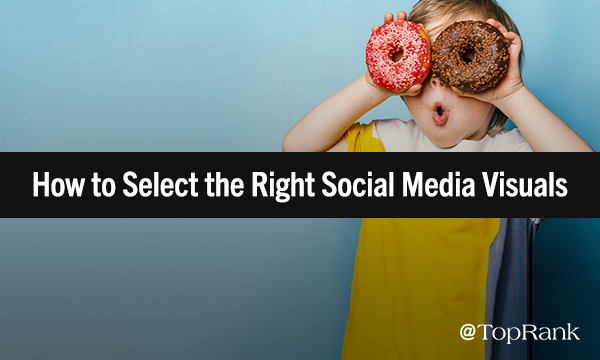 For both B2B and B2C brands, social media marketing has become an age-old tactic by now. And it’s no surprise. Despite working 8 hours a day and sleeping (hopefully) 8 hours, the average person still spends nearly two hours each day on social media, according to a study by Mediakix. But the social media landscape is changing—alot. Organic reach on Facebook is declining with changes to the Newsfeed, some of which are still rolling out. Twitter is struggling to retain their active users. Instagram is experimenting with long-form video content. LinkedIn is also investing in more video. Given these changes and regular updates, the best practices for each platform are constantly evolving. But what's one thing that isn't poised to change anytime soon? The importance of using eye-catching, compelling visual content to draw people in. Whether it’s YouTube, Snapchat, LinkedIn, or another social media platform, we know audiences consume content on those channels for a significant amount of time—they crave it. And if you want to make a positive impression, you have to go beyond ensuring proper image dimensions. You need make sure you're sharing the right visual content on the right platform. For both B2B and B2C brands, social media marketing has become an age-old tactic by now. And it’s no surprise. Despite working 8 hours a day and sleeping (hopefully) 8 hours, the average person still spends nearly two hours each day on social media, according to a study by Mediakix. But the social media landscape is changing—alot. Organic reach on Facebook is declining with changes to the Newsfeed, some of which are still rolling out. Twitter is struggling to retain their active users. Instagram is experimenting with long-form video content. LinkedIn is also investing in more video. Given these changes and regular updates, the best practices for each platform are constantly evolving. But what's one thing that isn't poised to change anytime soon? The importance of using eye-catching, compelling visual content to draw people in. Whether it’s YouTube, Snapchat, LinkedIn, or another social media platform, we know audiences consume content on those channels for a significant amount of time—they crave it. And if you want to make a positive impression, you have to go beyond ensuring proper image dimensions. You need make sure you're sharing the right visual content on the right platform.  To help you paint your content in the best light on social media and help create a positive experience for your audience, we asked our own Social Strategist, Meg McDougall, to share some best practices for selecting the right social images and video for some of the major platforms. Here’s what she had to say. To help you paint your content in the best light on social media and help create a positive experience for your audience, we asked our own Social Strategist, Meg McDougall, to share some best practices for selecting the right social images and video for some of the major platforms. Here’s what she had to say.
LinkedIn Social Image and Video Best PracticesThink About Your AudienceLinkedIn is the world’s largest professional network with over 562 million members and growing. But even though LinkedIn has a large audience of professionals, that doesn’t mean they exclusively want to engage in buttoned-up, stiff content. To make sure your pages, profiles, and articles are interesting and engaging for your audience, you need to know your audience really well. Do they like it when you show a little personality? Do they like more formal language or slang? Take a look at your LinkedIn Company Page analytics to see what types of content and messages your audience is engaging with to come up with a direction for your page.Take Advantage of VideoAnnounced in 2017, LinkedIn added the ability for members and brands to create and share video content. This gives content creators, publishers, and brands more opportunities to engage and connect with their audiences. Plus, LinkedIn video has autoplay enabled, making it easy for your audience to watch your content. Speaking of video, all of your motion graphics should be published as a video .mp4 file, not a .GIF. Many browsers and social media platforms are disabling autoplay for GIFs and are instead converting them into click-to-play videos. Instead of relying on the social platform to convert the GIF for you, take control of how your motion graphic will appear by creating the graphic as a video file from the start. Who’s doing it right? GE. Just take a look at one of their most recent posts (below). Their video on GE turbines has received 1,841 likes and 29 comments in less than 24 hours. As of July 10, just four days after posting, that count was up to 3,656 likes and 58 comments. The video also takes advantage of captioning to ensure that even with the audio off, audiences can still engage with and learn from their video.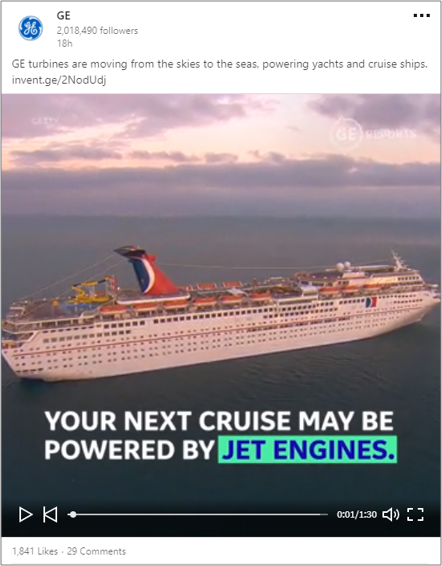
LinkedIn Image Specifications
Twitter Social Image and Video Best PracticesKeep Site Traffic in MindEighty percent of Twitter’s traffic comes from mobile devices. However, check your audience data in Google Analytics to see if mobile or desktop is your top traffic source for Twitter. Whichever device comes out on top, you should tailor your social imagery accordingly.Consider the Number of ImagesDepending on how many images you upload and attach to a post and which device its viewed on, Twitter will display them in different sizes and orientations. As a result, it’s important to remember how many images you want to share and how they will be seen on mobile versus desktop as they look very different. Here’s how multiple images look on mobile from Buffer’s guide to social media image sizes: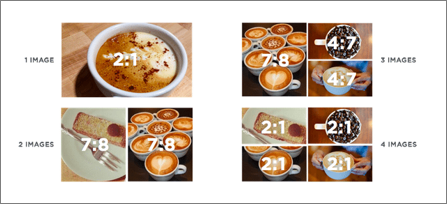 Image credit: Buffer And here’s how multiple images look on desktop: Image credit: Buffer And here’s how multiple images look on desktop: 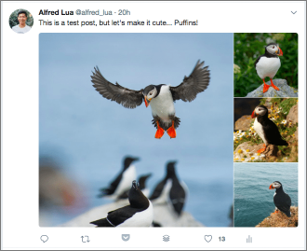 Image credit: Buffer Image credit: Buffer
Stand Out With Something CreativeA single day’s worth of Tweets could fill a 10 million page book—there are a lot of tweets out there that are saturating feeds. Make sure your content stands out with a creative image, graphic, video, or motion graphic. For example, try making a custom image to add additional context to the image and capture more attention. Tools like Canva or Venngage make those custom images easy—just remember to make them the correct size or your design may get cropped off. Who’s doing it right? Wendy’s. Already killing the game with their witty brand voice on Twitter, they also make sure they stand out in news feeds with custom images, memes, video, and other media. For example, in the tweet below, Wendy’s makes a timely reference to Avengers: Infinity War while also taking a fun shot at their competition (McDonald’s). The end result is a tweet with viral potential and over 230,000 likes.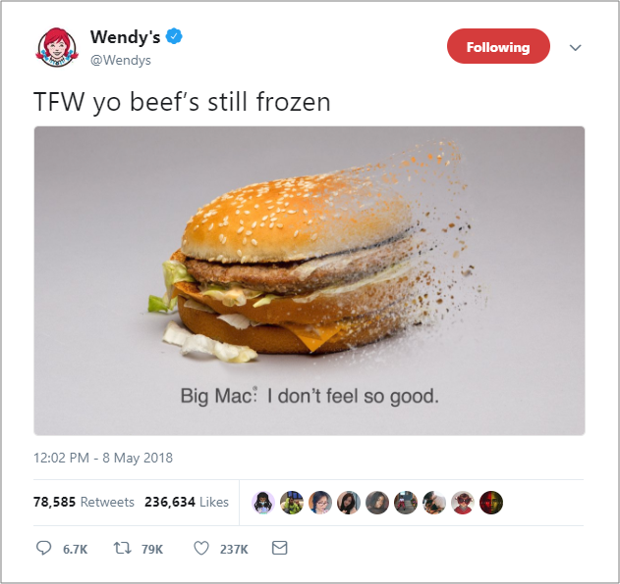
Twitter Image SpecificationsMobile Images: 1200 x 675 (16:9) Mobile Multiple Image Upload
Facebook Social Image and Video Best PracticesKeep Videos Short and SweetMore and more brands are creating more Facebook video as an average of 100 million hours of video are watched each day on the platform. Browsing through your own Facebook accounts, you’ll likely notice videos have taken over. Your eyes might be drawn to a video recipe from Tasty or a video from TechCrunch on the latest technology news. To create Facebook videos that drive the best results, create videos that are between 60 and 90 seconds long. In a study that analyzed 100 million Facebook videos, Buzzsumo found that videos between 60 and 90 seconds had the most engagement on Facebook.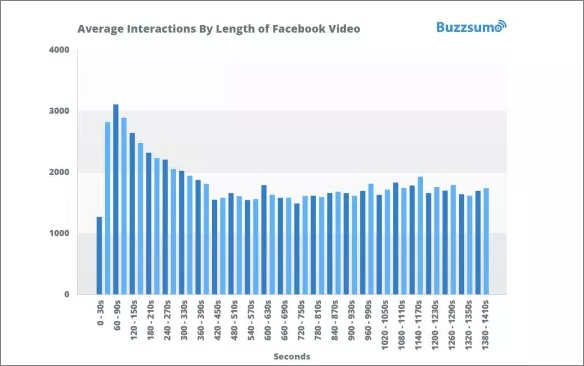 Image credit: Buzzsumo When it comes to Facebook video, it’s also worth noting that 85% of Facebook users watch videos without sound. Any narration or audio you include in the clip might not make it to a majority of your audience. To ensure that your message is communicated to your viewers who prefer silence, add captions or copy onto your Facebook videos. This way both types of viewers get the full impact of your content. Image credit: Buzzsumo When it comes to Facebook video, it’s also worth noting that 85% of Facebook users watch videos without sound. Any narration or audio you include in the clip might not make it to a majority of your audience. To ensure that your message is communicated to your viewers who prefer silence, add captions or copy onto your Facebook videos. This way both types of viewers get the full impact of your content.
Support Multiple Traffic Objectives With CarouselsOftentimes, social messages contain one link or call to action (CTA). However, Facebook is changing that with their new carousel page posts that can showcase multiple images, links, and headlines. As a collection of links and images, your Facebook followers can browse through your post to click on the link that’s most relevant to them. This makes carousels a great tool if you have a campaign with multiple landing pages or traffic objectives. Who’s doing it right? Skype. While carousels make a natural fit for promoting several or even one product, Skype went in a different direction. Instead of promoting one of their software products, Skype is using carousels to share and generate awareness for their work with The Young Actors Project.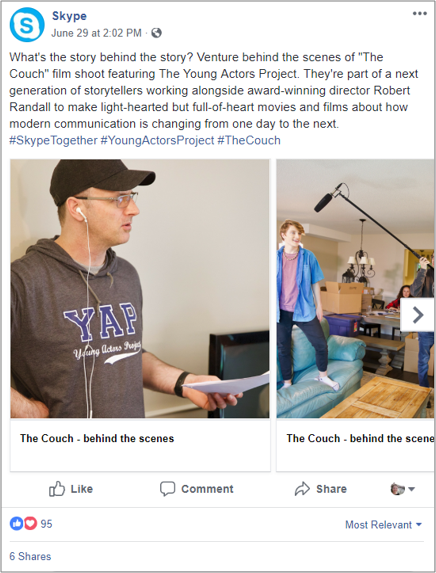
Facebook Image Specifications
Instagram Social Image and Video Best PracticesDon’t Be a SquareInstagram used to only allow images with a square, 1:1 aspect ratio. However, they now allow for both horizontal and vertical image content. This can be done in regular image uploads, but also in Instagram Stories. So, don’t feel like you have to keep your images in those tight, perfect boxes. Use whatever orientation and ratio works best for the image you want to share. Here's a great example courtesy of Buffer: Image credit: Buffer Image credit: Buffer
Drive Conversions With StoriesInstagram has been known to marketers for making it a little harder to share links. On Instagram, URLs and links don’t work in the description of traditional image uploads. As a result, many brands use their profile bio to add in a URL and update it for each campaign. This is a good workaround, however, it requires a lot of additional clicks and steps from both audiences and social media marketers. Instagram Stories, however, offer a better solution. Through stories, accounts with over 10,000 followers can attach a link to your post that audiences can visit by swiping up. This makes it easy to drive traffic to your target pages and drive more conversions. Plus, your audience doesn’t have to leave the Instagram platform to view the link—they can stay directly within the Instagram interface. Don’t have 10,000 followers on Instagram? Getting your account verified will also do the trick. Who’s doing it right? Apple. Using Instagram Stories to tease their brand videos are captivating and engaging pieces of content. Taking advantage of both image and video, Apple knows how to pull people in and get them invested in a good story. To drive traffic to their objective pages, they’re also utilizing Instagram’s swipe up feature.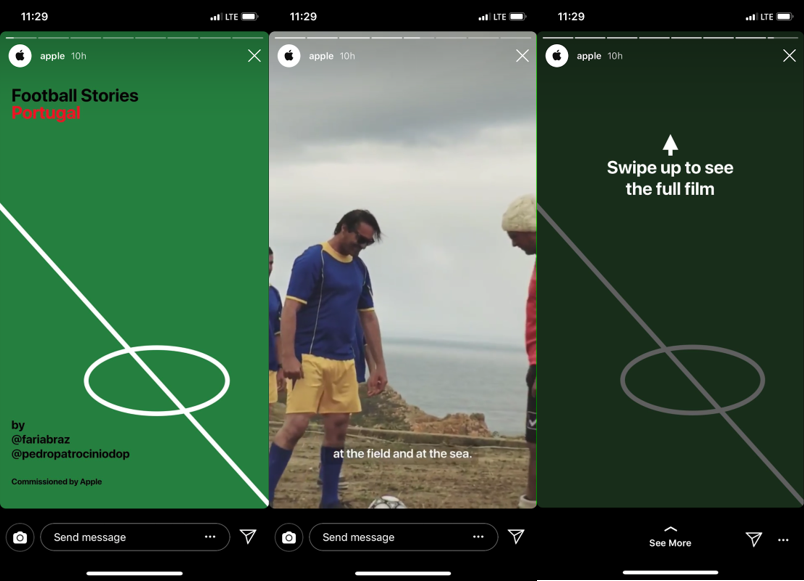
Instagram Image Specifications
Size Up Your Social CampaignsSocial media is an important piece of any content distribution or promotion strategy. With each platform having a unique voice, purpose, and target audience for your brand, it’s important that you customize your social images and videos for each one. Whether that means customizing the image size, picking individual images for each platform, or creating a special video, the more you tailor your social imagery, the better. Need help finding the perfect image for your content? Read our guide on how to find and choose dynamic images.If you’re ready to dive into the world of video, make sure you’re creating the right videos with our guide to the different types video for B2B marketing and when to use them.The post Best Practices for Choosing Effective and Captivating Social Media Visuals appeared first on Online Marketing Blog - TopRank®. Mobile Marketing via Online Marketing Blog – TopRank® https://ift.tt/faSbAI July 30, 2018 at 07:08AM
https://ift.tt/2vi9LPI
Pioneer Of Humanability: Sixto Cancel https://ift.tt/2mPNULQ  In an interview with PSFK, working in collaboration with Verizon, Sixto Cancel discusses how he is using technology for good with his work for Think of Us In a special series brought to you with the help of our partner Verizon, The Pioneers of Humanability is directing the spotlight onto the people, organizations, and companies who are using technology to do more new and do more good in the world. Many U.S. youth who are in the foster care system will “age out” of the system at 18 or 21 and automatically be left without a family or the skills to make it on their own. Sixto Cancel, Founder and CEO of Think of Us and one of the Pioneers of Humanability, is using technology to give these youth the tools they need to successfully navigate adulthood. In this interview, Sixto describes how Think of Us created an app-based platform to connect youth with a support network of adults from non-profit and government agencies who can help coach them in their journey towards self-sufficiency. PSFK: What are the ways in which you think technology has the potential to impact humanity, and make a positive social difference? Sixto Cancel: The way that I’ve seen technology making a difference in human services—and for humanity—is when technology really focuses on connecting us humans more than ever before in the moments of need. It’s not to automate and replace human connection with an online platform, but I think the technology can play a stronger role in actually coaching folks through situations. We can use technology to say, “Hey, I’m going through this,” and a person will say, “Hey, I want to support, and I want to be there with you.” Technology can do the work of saying, “Hey, as you think about supporting this person, here’s what you can do. You can hold space with them. You can show up.” Technology can help you actually walk through with someone in need, and help them process what their need is, and then get to the next level of healing. I think technology can play a role in making a difference because of how it prompts, how it engages, and how it actually facilitates more in person human connection. PSFK: Could you give us a specific example of how your platform on Think of Us is facilitating this connection? Sixto: Absolutely. One example that comes to mind is when a young person using our platform says that they need help creating a résumé. They could shoot it back and forth a couple of times on email or hop on the phone with someone, and be able to accomplish a goal, but there’s nothing like being able to actually show up and say, “Let’s do this together, and let’s sit side by side, and work on it.” We want to go to the next form of connection where the technology is actually coaching adults to be able to show up in person. We want to be able to show them how they can help and coach the young person through completing their résumé instead of just saying, “Let me give you feedback. Let me review what you’ve done.” The way we use technology is helping guide the support of people to build their capabilities to do things differently. PSFK: How does your platform help guide people through this process? Sixto: On our platform, young people can create their goals and then create action steps to achieve those goals. Their goal might be to go get a job, and so action step number one is that they need to create a résumé. When they say they need to create a résumé, we have video content and articles that are then shared with a supportive adult and the young person to help them do that. PSFK: How is Think of Us working to do more new and do more good? Sixto: Young people age out of a foster care at 18 or 21, depending on the state. We are working with young people who are aging out and not getting adopted or returning to their biological families and have to figure out how they’re going to be completely self-sufficient. Where are you going to live? Where are you going to be able to get a job? Where is it that you might want to go to school? How do you take care of your own mental health? How do you take care of all the things that adulthood requires you to do? Our platform helps young people build their own personal advisory board to help them create that transition plan, and then to execute that plan. PSFK: What inspired your work to focus on supporting youth within the foster care system? Sixto: I myself grew up in the foster care system and aged out of it, as did some of my colleagues. My work very much comes from that experience of having to navigate those experiences on my own. PSFK: What are some of the biggest challenges that your organization has to overcome? Sixto: I think the biggest challenge is, just like many nonprofits, fundraising. However, I look at it as having the capital to actually do the work. Tech companies work in a way where they are infused with a round of capital. Then they hit certain milestones and get another round of capital based on their successes. Whereas, in the non-profit field, you have a three-year work plan. You get a grant to accomplish the work, then you evaluate that work and show that you’re making a difference. We’re at an interesting intersection with Think of Us, because we need to function like a tech company, but we have the social mission of a non-profit. It becomes complex in how we actually navigate those things. PSFK: What would you say makes your organization different from other support networks? Sixto: I think it’s the fact that we put the young person at the center, giving them voice and choice. We really want young people to start surviving and really start to be able to own their destiny and have a life where they’re actually living. When you come into foster care, it’s because of abuse, neglect or because your parents can’t take care of you. Those are all reasons that you had nothing to do with. Our platform and our work is about making sure that every young person has the same opportunities that any of their peers would have had. PSFK: What types of tools does your organization provide and who stands to benefit from them? Sixto: Our main tool is a life coaching-platform where young people are able to create goals. They’re able to tag members of their personal advisory board to support them in accomplishing and executing the tasks within that goal. We also have content on the platform to help them. PSFK: What are some of the biggest success stories that the platform has had so far? Sixto: I would say some of the biggest success stories that we’ve had so far was when we did a soft launch in Nebraska where we had 70 young people get onto the platform in the first 90 minutes. They created 67 goals. What was so enlightening and what made us really happy was that out of the 67 goals, 62% of those goals had to do with financial literacy or purchasing some type of asset, such as a car or housing. What it showed was that the group of 19- and 20‑year‑olds that we had in that room all had a strong grasp of what they needed to do in terms of managing their money to be able be self‑sufficient. There are a lot of different opinions that people may have about adolescents and Millennials can do, but what we saw on our platform was that young people, who could have chosen any goals in the world, chose goals that were directly related to something that had to do with being a hard worker or learning a new skill around money. That really gave us an insight on what is it that top of mind for young people who have aged out of foster care. PSFK: Was there else that you wanted to share about Think of Us that we forgot to ask? Sixto: What I love about our work is that we’re not here trying to create a new program for young people in foster care. We’re here to work with the existing programs and partner with them, bringing technology and data to the table. We can show them how they might be able to use real‑time data that they’re learning about young people’s goals, young people’s wants and young people’s needs and then be able to utilize that data to do their work better. I really enjoy helping organizations. Our team of 15 people really enjoys being the thing that lifts up the good work that’s being done by others, so we can make sure that young people are being served in a holistic way. Addressing the challenges facing youth who are aging out of foster care is possible with technology platforms like the one Think of Us has built. For more about how innovators like Sixto are using technology to serve progressive goals and better the community for all, see the Pioneers of Humanability, brought to you by PSFK with Verizon. Verizon’s Pioneers of Humanability list honors the people, organizations and companies that are using technological innovations to bring about good things for the world. These are the pioneers, keeping food safe and water clean, cutting pollution, saving energy and enabling doctors to treat patients a county or a country away. They’ve stopped asking “What if?” or “Why isn’t?” and started doing and leading. These are the people, organizations and companies you need to know about now—because they’re building the future. Mobile Marketing via PSFK http://www.psfk.com/ July 30, 2018 at 07:02AM |
CategoriesArchives
April 2023
|

 RSS Feed
RSS Feed
